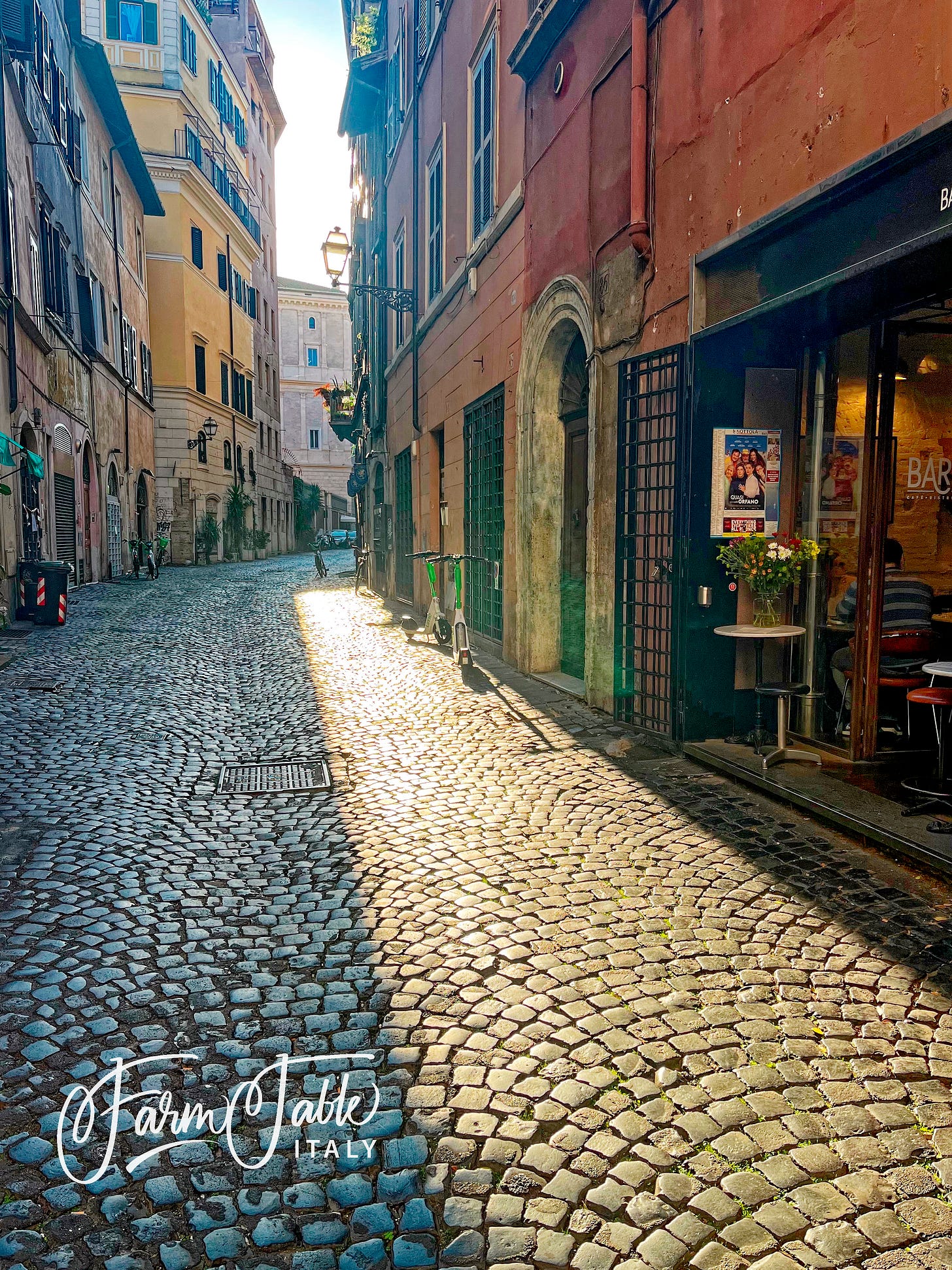Better Travel to Italy
You may be doing it wrong.
I’m going to venture away from Italian food and experiences and provide some advice that I think many American travelers to Italy will benefit from ... even if it might be difficult to hear. I’m not trying to be provocative with the subtitle of this post. Your travel is your own; and you should always do whatever suits your tastes. But I am suggesting that, if you look closely at your assumptions and the reasons why you are traveling, there might be a better way.
This will not be a step-by-step guide; rather it’s about how you approach travel. In short, it’s about how to do travel well. On the home page of Farm Table Italy, there is a post regarding my offer of travel planning services in which I describe my own philosophy of travel. Ironically, my framework started with some startup business planning with a good friend many years ago (h/t: Tim) It envisions travel as something loosely analogous to a three-act theatrical play. The first act is planning (similar to the introduction of the characters and setting the scene); the second is travel itself (the main action of a play); finally, act three is a kind of memorialization (how the story ends and how the characters change.) It’s not a perfect analogy, but it works when you start to break it down.
Act I: Don’t Be Afraid.
Planning is the timing and logistics of your travel, but also about something just as important: anticipation. Guide books, meeting with your fellow travelers, reading Substack (!), exploring online -- all these activities will serve to heighten the excitement for your upcoming trip. This leads me into one of my first lessons for doing travel right: don’t be afraid.
Depending on how much you have traveled or if it’s your first trip abroad or to Italy, you may feel nervous or apprehensive. That’s natural and it results in a natural side effect: caution. Confronted with many choices and unknowns, people will have a natural tendency toward the “safe route” when that fear of failure becomes too strong. That can take the form of choosing to stay at an American branded hotel in an busy location as opposed to a smaller, well-placed Italian B&B. Or eating at a restaurant with English menus and great Google reviews (from Americans) as opposed to a smaller trattoria full of locals speaking Italian. But is taking the safe option really why you are taking this trip?
It is easy to book a hotel or hand your experience over to a tour company because it feels like risk mitigation. But you should realize that avoiding any risk means that you’ve also left a lot of discovery and experience on the table. I would suggest that you think about and plan your trip as if it has already happened. What do you want to have seen or experienced on your visit? Be intentional. As with life in general, people rarely look back and celebrate having taken the safest route. Travel is an adventure and a journey into the unknown … embrace it. If you plan well & seek out good advice, I believe you will find the results will be worth it.
Booking from most large tour companies will leave you sitting on a bus looking out a window or following a tour guide holding an umbrella through throngs of other tourists. Instead, think about finding a small hotel in a neighborhood and get to meet the people you came so far to see; seek out local guides and walking tours to see things up close. As opposed to staying in a hotel near the Trevi Fountain in Rome, explore AirBNBs or VRBOs in a Roman neighborhood away from the center where locals live and get a feel for the rhythms of the city that are impossible from a cloistered hotel or tour bus. Or better yet, add a stop in the countryside at an agriturismo (working farms with rooms to rent) and experience a different side of Italy.
Regardless of how you want your trip to be, try to use your Act I planning to learn as much as you can; take ownership of what you’d like to do and try to embrace the excitement and nervousness that you feel; the looking forward is rewarding in itself!
Act II: Festina lente. (“Make haste, slowly.)
Your bags are packed and your flights are booked and the day has finally come. Act II is the journey itself; where all the planning comes to life. Maybe you have only been on a plane a handful of times or maybe you take flights twice a week for work. Either way, nothing is quite as exhilarating as beginning a journey to a destination that you have thought about and planned for months.
My advice is plan, prepare and then slow down and don’t worry. Your trip is never going to be perfect. If you let go of that expectation, you paradoxically free yourself to have a better experience. Perfect travel is impossible; expect the unexpected. You may make a mistake in your planning and not realize that the museum you want to see is closed on the day you want to go. Unexpected events can intervene in Italy. Things will not always go according to plan. Bad weather, airline or train delays, and other unforeseen gremlins will crop up. But try to remember that your trip is greater than the sum of its parts. If you have done your homework and planned well, you can adjust to pretty much anything that occurs. Slow down & relax. The thing that didn’t go the way you hoped might well result in an opportunity you would have never seen coming ... and could never have expected. So roll with it make adjustments when you need to. That flexibility is a life-skill; not just a travel-skill.
Finally, don’t expect everything that you take for granted in daily life in the U.S. to be the same in Italy. Day-to-day life in any Western European country is perfectly manageable for Americans, but there are quirks. For example, rather than hailing a cab in the street, you may need to find a taxi stand where the cabs congregate. There are perfectly good reasons why it’s different so don’t be surprised. If you expect differences and ask for advice, it will all work out well. Travel is not about bringing America to the world; it’s about you experiencing a culture and way of life that is different and growing from it.
“Even though it’s al dente, it’s still good”
My family and I were staying in a small, hilltop village in central Tuscany very near a cluster of Chianti wineries. The town had a single, small restaurant that was family owned and offered excellent local cuisine. Because we were staying in the village for an extended period of time, we visited more than a few times. The waiters got know us and loved that my boys ordered using polite Italian language ordering etiquette. One day, an American family came in while we were there. They weren’t the stereotypically rude Americans; but they did seem to expect (rather loudly) that the restaurant would have the internationalized Italian food they wanted. After some back and forth over the menu -- written in Italian -- they settled on a few simple pasta dishes. After the food was served, the waiter checked in ... and the mother in the group pronounced her verdict on the pasta stating awkwardly,“even though it’s al dente, it’s’ still good.” To this day, my family and I share a smile and maybe an eye-roll at that memory. Of course it’s good; while Italians may not have invented pasta, few would argue that they have perfected it in all it forms. Beyond that, I like to think that she learned that maybe her expectations -- more so than the pasta -- were a bit “al dente”.Act III: Memorialization.
Act III is capturing the memories of your trip. Before you starting planning your Instagram posts, I would urge you to think more broadly. These are the moments captured in your mind, in your camera, in a notebook that you take with you to capture your thoughts and feelings during the travel. Memories fade and writing your daily events and experiences reminds you of the things that can get lost during your trip. Travel is usually so busy, it’s easy to forget these small details. Take quick notes so as not to lose the memory. Do it when you sit down for a coffee or just to take a break. Capture the highlights and fill in the details later at the end of the day or when jet lag keeps you up at night. Organize the photos and videos you took during the day when you have a moment.
Speaking of photos, Italy is a beautiful country so you will want to take pictures to remember your trip. I’m an amateur photographer myself and I know how satisfying it can be to capture a moment or a vista. But recognize a few things: you’re not the first person take a selfie at the Trevi Fountain. (Sadly, social media has become a scourge at the many popular tourist destinations and an annoyance to locals and travelers alike.) Look for the photo that hasn’t been repeated a million times on Instagram. I’m sorry, but the world does not need another TikTok video of the Pantheon and certainly not preening in front of St. Peter’s Basilica. So maybe just keep those photos and videos for yourself or just share with your family.
Finally, here is some quick takeaway advice that applies to Italy but could as easily apply to anywhere in the world:
Let Italy be Italy.
I had a boss who used to say “Take the world as you find it, not as you would have it be.” Don’t expect it to be America with better food and deeper history. While that’s true, try to embrace its unique way of life and customs.
Travel like a local.
As much as you can, try to experience Italy like a local. If you see a restaurant with an English menu full of Americans, keep walking. Find one where you see mainly locals and you’ll eat better and probably learn some Italian. Especially in smaller cities and in villages, take a late afternoon walk (passeggiata) around 5pm. Notice the grandmothers and daughters and granddaughters walking together and wonder why that doesn’t happen in the U.S.
Speak some Italian.
Try to learn a little Italian before you travel but certainly don’t feel like you need to be fluent. Italians can spot that you’re American from a mile off and, unless you speak pretty well, they usually won’t reply in a staccato quick response. But I have always found that Italians generally love when visitors make an effort to say a few words in their language. It’s taken as a form of respect that you try and is always appreciated.
You’ll most likely return.
When folks approach me about a one-time trip to Italy, I tell them that they’ll probably want to go back. Italy seems to be like that; it gets under your skin because they seem to practice a lifestyle that we Americans naturally appreciate. So assume you're going back and go a bit slower. You cannot squeeze a trip to Rome or Florence into 2 days anymore than you could visiting New York City or Washington. So slow down a bit and assume you’ll be returning; it’s a safe bet you will.
Please reach out if I can be helpful in your planning.






Yes to all of this. I would say the same about travel to France.
Well done David… you open a small window in the heart of each of us who wants to travel…